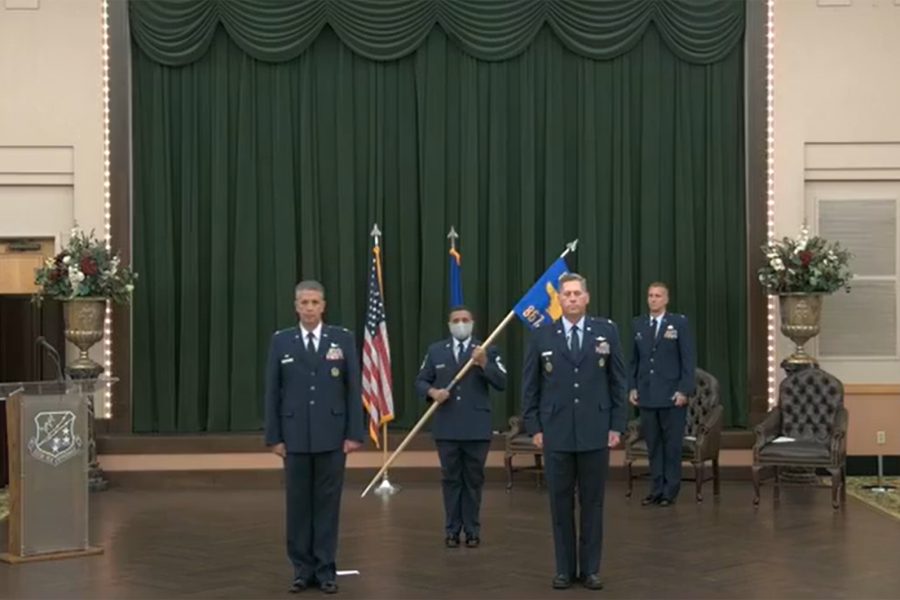A new 867th Cyberspace Operations Group stood up at Joint Base San Antonio, Texas, on Sept. 18 to streamline the Air Force’s cyber offense and defense, as well as its intelligence collection in the digital realm.
Sixteenth Air Force, which oversees information warfare in the service, provides cyber expertise to U.S. Cyber Command and others across the Pentagon. The new group answers to the 67th Cyberspace Wing and sits alongside the 67th, 318th, and 567th Cyberspace Operations Groups. It will oversee the 315th, 341st, 833rd, and 836th Cyberspace Operations Squadrons.
“We now have the ability to focus on two distinct mission sets,” Col. Lauren Courchaine, commander of the parallel 67th Cyberspace Operations Group, told Air Force Magazine on Sept. 17. “While they’re still both focusing on offensive cyberspace operations, [group Commander Col. Travis Howell] … has the ability to truly focus on the cyber national mission force and the prosecution of malicious cyber actors.”
Each of the military services offer cyber mission force teams to CYBERCOM for a range of offensive and defensive work, from protecting the integrity of U.S. elections to defending against hackers or assisting partner countries facing an influx of disinformation.
Howell’s cyber national mission teams in the 867th COG “defend the nation by identifying adversary activity, blocking [attacks], and maneuvering to defeat them,” according to the Defense Department. The services began training their teams in 2013, and all 133 teams became fully operational in 2018.
Howell said the reorganization shows the Air Force cyber staff is learning how to plan better for operations. It’s an evolution that moves beyond simply organizing, training, and equipping cyber forces, he said.
“As the force was maturing, the teams were maturing, as CYBERCOM was coming together and maturing as a staff and putting out their orders to go execute, there was a … maturity issue at the operational level,” Howell said. “What this opportunity affords now is that you have unity of command and force presentation, not only through my group but as well as Lauren’s.”
While Howell handles those units, Courchaine can focus on what combatant commands around the world need, like protecting air defense systems from electronic attack. That means her Airmen in the 67th COG can spend more time gathering information on what bad actors are doing on digital networks and the electromagnetic spectrum, assessing security, and attacking when needed.
“Under one chain of command, I have intelligence Airmen sitting next to cyberspace Airmen sitting next to developers and acquisition professionals,” she said. “There is a constant … loop of innovation and refinement of not only capabilities, but thoughts and operations.”
That was happening before the Sept. 18 realignment, but Courchaine argues missions weren’t as effective as they could be because cyber-focused intel personnel were pulled between two different commanders in the 67th Cyberspace Wing and 70th Intelligence, Surveillance, and Reconnaissance Wing.
Howell, who until recently served as CYBERCOM’s current operations division chief, said the information warfare field needs to think differently than it did 10 years ago in the early stage of the cyber mission forces.
The 867th COG and CYBERCOM both want Airmen to have an evolving skill set that matches the rapidly changing digital era, possibly with career fields and training that look different from what currently exists. The cyber enterprise wants to move past the traditional means of intelligence collection—tracking things like online communication and surveilling networks—and do more with publicly available information like social media posts and GPS tracking.
“We’re not there yet as a service to look at the capacity of those Airmen and those career fields and do that realignment, but I think that is where we need to start asking some hard questions about, can we get there as a service?” Howell said.
Airmen are still fairly new to thinking about how digital information can translate into military action in the physical world. In an era where adversaries can track military personnel’s habits through apps like the workout mapper Strava or the brewery logger Untappd, the Air Force wants to improve its training and software so it can do the same.
As demand for their skills continues to grow, the 67th Cyberspace Wing and its organizations are trying to do better for the Joint Force while combating burnout. It’s tough to recruit new cyber operators when people can get more money and job flexibility in the private sector, so the force is making do with the manpower and resources it has amid an election season and global pandemic.
The 67th COG has seen fewer than five coronavirus cases so far, Courchaine said, and they’re trying to keep it that way.
“We’re working 24/7/365 and I have crews that, in some respects, are the experts not only in the Air Force, but in the Department of Defense, so I have to make sure that I can maintain that capacity,” Courchaine said. “We’ve done things like make sure that we have cots and sleeping bags and [meals ready to eat] in the event that there is a large outbreak of COVID and that I have to deploy my Airmen in place so that I can maintain mission readiness.”
“We’ve really had to put our arms around their families as well and find ways that we can still maintain the resiliency of the family unit so that our members can wake up every day and go do a very, very important mission,” she added.
